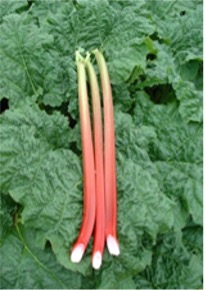 The Whitwell family of Leeds are thought to be the first large-scale growers, and in 1877 built special sheds dedicated to “forcing” rhubarb out of season when there was nothing else so early in the year. As rhubarb’s popularity increased so did the number of Yorkshire producers, centralised between Leeds, Wakefield and Bradford. It became known world-wide as The Rhubarb Triangle because of three things.
The Whitwell family of Leeds are thought to be the first large-scale growers, and in 1877 built special sheds dedicated to “forcing” rhubarb out of season when there was nothing else so early in the year. As rhubarb’s popularity increased so did the number of Yorkshire producers, centralised between Leeds, Wakefield and Bradford. It became known world-wide as The Rhubarb Triangle because of three things.
1. This area, in the shadow of the Pennines gets plenty of rain and is a natural frost pocket.
2. The massive Yorkshire coalfields provided a cheap local source of fuel to heat the sheds.
3. Earlier in 1813, Batley Benjamin Law became the first person to organise, on a larger scale, the activity of taking old clothes and grinding them down into a fibrous state that could be re-spun into yarn. This product was called “Shoddy” as it was poorer quality than newly spun wool. In 1860 the town of Batley alone was producing over 7000 tonnes of shoddy. This was ideal for the rhubarb industry as a high nitrogen feed. It was cheap, readily available and when laid on the soil the nitrogen was released slowly over a three year period as the fibres break down.
This combination where a local waste product produced better quality fruit meant the Yorkshire crop was cheaper and better quality. When rhubarb was the nation’s favourite there were well over 200 producers , and eventually those in other areas of Britain could not compete. The railways put on special trains known as the “Rhubarb Express” trains as they moved the valuable fruit to markets particularly the old Covent Garden market in London , and from there large amounts were sold on into Europe. After the war it fell out of fashion and by the 1960’s confidence that forcing could be profitable was low and many producers sold their farms, in the main to two families who kept the industry alive by buying particularly good farms when they came on the market. In 1965 this partnership became a company- E.OLDROYD & SONS (Lofthouse) Ltd. and worked towards building up the industry.
Eventually, 12 farmers in the Rhubarb Triangle applied to have the name "Yorkshire forced rhubarb" added to the list of foods & drinks that have their names legally protected by the European Commission's Protected Food Name scheme & gained Protected Designation of Origin status.
| 1st March 2010 | Janet Oldroyd Hulme | European Commission for protected foods |  |
Following 6 years work by Janet Oldroyd Hulme on behalf of the remaining growers the commission awarded their top level status protected designation of origin (PDO) to Yorkshire Forced Rhubarb |